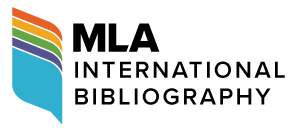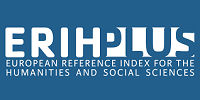Editorial guidelines
LANGUAGE
Texts should preferably be written in French. They can also be written in English or Spanish. Depending on the language chosen, the author must respect the spelling conventions of that language.
LENGTH
The articles will extend between 40,000 and 60,000 characters (spaces included), summaries, notes, bibliographical references and appendices included. They must be presented in electronic document format .doc, justified, with single spacing. The left and right margins will be 3 cm; the top and bottom margins, 2.5 cm. Times New Roman typeface. The pages of the text should not be numbered.
TITLE
The title will be centered, lowercase, bold, size 14.
FIRST AND LAST NAME
Before sending an article to HYBRIDA, a profile must be created with certain personal and professional data as well as a short biographical note (for example, department, university, profession, areas of interest, etc.).
The author's first and last name should not appear in the article, nor any personal markings in the computer document (look in Microsoft Word> file> properties> summary tab: remove personal information from there).
SUMMARY AND KEYWORDS
The article should be preceded by three abstracts of a maximum of 10 lines in three languages: French, Spanish and English (size 10). The abstract will be preceded by the title of the article in the two languages different from the language of writing.
After a blank line, you will have to write 3 to 5 keywords, in lowercase, size 11, separated by semicolons, in the same language as that of the summary. The statements Résumé / Keywords, Resumen / Palabras clave, Abstract / Key-words, will appear in lowercase, in bold, size 11. For the other two summaries, you must leave two blank lines after the key words of the first summary.
COMPOSITION OF THE TEXT
The body of the text will begin on the second page. Size 12. The first line of each paragraph will be marked by using the tabulation key (standard Word, 1.25 cm). No word should appear in bold, italics or underlined, except the words belonging to a language different from that chosen for the writing of the article or those that the author wants to highlight and which can be written in italics. The titles of the works cited (books, magazines, newspapers, works of art, etc.) must appear in italics.
It is advisable not to overuse sections and / or subsections in the development of the text. If there are any, the titles (including the introduction and the conclusion) will be numbered consecutively (1, 2, 3, 4…), separated by two blank lines from the previous paragraph and one line in white of the following paragraph, in lower case, in bold, size 12. The sub-titles (1.1., 1.2, 1.3, 1.4…) must also appear in lower case, in bold, size 12, leaving a blank line (before and after).
QUOTES
HYBRIDA considers it essential that all the sources consulted be cited.
Quotes of less than 40 words will be embedded in the text between double quotes. For quotes included in another citation, use single quotes (‘...’). Quotes of more than 40 words must be separated from the body of the text by leaving a blank line before and after and will be marked by a double use of the tabulation key (standard Word, 1.25 cm), without quotes and without italics (even those written in a language different from that of the article). Size 11.
In these two types of citation, the source consulted should be indicated immediately after, according to 7th edition (2019) of the citation in APA style: (Segarra, 2010, p. 103).
TABLES AND FIGURES
The illustrations (figures, graphics, diagrams, tables, etc.) inserted in the text must be of sufficient quality to ensure their correct reproduction and will be numbered, if necessary, below (figure 1, figure 2, figure 3, etc.). If you reproduce documents protected by Spanish Intellectual Property Law, you must have the corresponding authorization. The presentation of these authorizations will be the responsibility of the authors of the articles.
INFRA-PAGINAL NOTES
They will only be used for additional clarification. Size 10.
The infra-paginal references will be numbered in Arabic numerals and continuously (1, 2, 3, 4…). The footnote reference will appear in the text immediately next to the corresponding word, in front of the punctuation marks. Use the automatic function of Word for this.
ABBREVIATIONS
The abbreviation 'ibid.' is not used in the APA style ”. Nor is any other abbreviation used to avoid the repetition of the author's name or work.The use of abbreviations should be avoided as much as possible.
BIBLIOGRAPHY
Preceded by the statement Bibliographical references (in bold, composed in indent on the left, size 12), the works cited in the article (these only), according to the latest version of the citation in APA style (7th edition, 2019 ), must appear at the end of the text, after two blank lines, respecting the alphabetical order. A bibliographic reference is made up of four essential elements: the author (s) (or responsible for the text), the date of publication, the title and the source (place of consultation or acquisition). You can also use the square brackets […] to specify the type of material referenced. Include, if possible, the DOI reference or the URL of the document.
The journal HYBRIDA is firmly committed to gender policies that lead to real equality between women and men in our scientific community and in society in general. Therefore, the journal invites authors to include the full names of those who appear in the bibliographical references of each contribution, even though the APA norms indicate that only the abbreviation should be used.
Here are some examples of bibliographic references.
For books:
Maalouf, Amin. (1998). Murderous Identities. Grasset.
Taïa, Abdellah. (2015). A country to die. Threshold.
For book chapters:
Segarra, Marta. (2010). Orientalism and the reappropriation of the Orient: Nina Bouraoui. In M. Segarra, Nouvelles romancières francophones du Maghreb (pp. 103-114). Karthala.
For articles:
Monleón Domínguez, Ana. (2017). Representations of non-normative sexualities in fiction films by Nadia El Fani. Expressions maghrébines, 16(1), 169-182. https://doi.org/10.1353/exp.2017.0010
Pujante González, Domingo. (2020). A secreto a voces: los relatos íntimos by Niki de Saint Phalle. Thélème, 35(2), 251-259. http://dx.doi.org/10.5209/thel.70613
For Theses:
Vásquez Sáenz, Henry. (2020). Copi's theater: trans processes and strategies. Une aproche queer [Doctoral thesis]. University of Valence / University of Strasbourg. http://www.sudoc.abes.fr/cbs//DB=2.1/CMD?ACT=SRCHA&IKT=1016&SRT=RLV&TRM=henry+ferney+vasquez+saenz
For Movies:
Sprinkle, Annie & Harlot, Scarlot. (Directors). (1999). Annie Sprinkle’s Herstory of Porn (1996-1997) [Movie]. Annie Sprinkle.
For other types of references, please see 7th edition APA style citation:
https://libraryguides.vu.edu.au/apa-referencing/7GettingStarted















